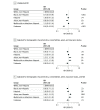Assessment of Racial/Ethnic Disparities in Hospitalization and Mortality in Patients With COVID-19 in New York City
- PMID: 33275153
- PMCID: PMC7718605
- DOI: 10.1001/jamanetworkopen.2020.26881
Assessment of Racial/Ethnic Disparities in Hospitalization and Mortality in Patients With COVID-19 in New York City
Abstract
Importance: Black and Hispanic populations have higher rates of coronavirus disease 2019 (COVID-19) hospitalization and mortality than White populations but lower in-hospital case-fatality rates. The extent to which neighborhood characteristics and comorbidity explain these disparities is unclear. Outcomes in Asian American populations have not been explored.
Objective: To compare COVID-19 outcomes based on race and ethnicity and assess the association of any disparities with comorbidity and neighborhood characteristics.
Design, setting, and participants: This retrospective cohort study was conducted within the New York University Langone Health system, which includes over 260 outpatient practices and 4 acute care hospitals. All patients within the system's integrated health record who were tested for severe acute respiratory syndrome coronavirus 2 between March 1, 2020, and April 8, 2020, were identified and followed up through May 13, 2020. Data were analyzed in June 2020. Among 11 547 patients tested, outcomes were compared by race and ethnicity and examined against differences by age, sex, body mass index, comorbidity, insurance type, and neighborhood socioeconomic status.
Exposures: Race and ethnicity categorized using self-reported electronic health record data (ie, non-Hispanic White, non-Hispanic Black, Hispanic, Asian, and multiracial/other patients).
Main outcomes and measures: The likelihood of receiving a positive test, hospitalization, and critical illness (defined as a composite of care in the intensive care unit, use of mechanical ventilation, discharge to hospice, or death).
Results: Among 9722 patients (mean [SD] age, 50.7 [17.5] years; 58.8% women), 4843 (49.8%) were positive for COVID-19; 2623 (54.2%) of those were admitted for hospitalization (1047 [39.9%] White, 375 [14.3%] Black, 715 [27.3%] Hispanic, 180 [6.9%] Asian, 207 [7.9%] multiracial/other). In fully adjusted models, Black patients (odds ratio [OR], 1.3; 95% CI, 1.2-1.6) and Hispanic patients (OR, 1.5; 95% CI, 1.3-1.7) were more likely than White patients to test positive. Among those who tested positive, odds of hospitalization were similar among White, Hispanic, and Black patients, but higher among Asian (OR, 1.6, 95% CI, 1.1-2.3) and multiracial patients (OR, 1.4; 95% CI, 1.0-1.9) compared with White patients. Among those hospitalized, Black patients were less likely than White patients to have severe illness (OR, 0.6; 95% CI, 0.4-0.8) and to die or be discharged to hospice (hazard ratio, 0.7; 95% CI, 0.6-0.9).
Conclusions and relevance: In this cohort study of patients in a large health system in New York City, Black and Hispanic patients were more likely, and Asian patients less likely, than White patients to test positive; once hospitalized, Black patients were less likely than White patients to have critical illness or die after adjustment for comorbidity and neighborhood characteristics. This supports the assertion that existing structural determinants pervasive in Black and Hispanic communities may explain the disproportionately higher out-of-hospital deaths due to COVID-19 infections in these populations.
Conflict of interest statement
Figures
References
-
- Artiga SG, Garfield R, Orgera K. Communities of color at higher risk for health and economic challenges due to COVID-19. Kaiser Family Foundation April 7, 2020. Accessed October 26, 2020. https://www.kff.org/coronavirus-covid-19/issue-brief/communities-of-colo...
-
- US Centers for Disease Control and Prevention COVID-19 in Racial and Ethnic Minority Groups. Centers for Disease Control and Prevention; 2020.
MeSH terms
LinkOut - more resources
Full Text Sources
Medical
Miscellaneous


